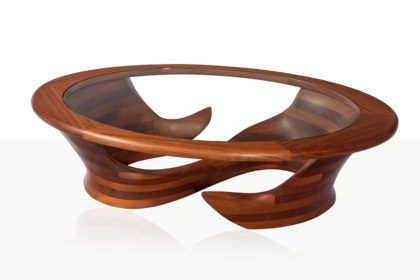
I’d like to share a few thoughts about what I call “occasional tables”. There are all manner of tables with many different uses. It’s sometimes difficult to identify the true nature of a table one sees. It has been my experience that often clients who are looking for a custom made table to fit a specific niche feel bewildered by the range of kinds of tables. The size, dimensions and even design of each kind of table are determined according to the function it needs to fulfill. I shall now endeavor to make some order out of all this.
As can be seen in my web site, I’ve created several sub-categories under the “Tables” heading. Here, however, for simplicity’s sake, I’ll break up the category into three major sub-divisions:
- Dining tables
- Desks and work tables
- Occasional tables
The first two categories are self explanatory. The subject of this essay is the latter. Basically, the occasional table is any table which doesn’t fall into either of the first two categories. There is a common assumption, partially legitimate, that these tend to be smaller pieces that can be easily moved around to accommodate needs as they arise on occasion. Perhaps this is the source of the term. However, it may also be derived from the fact that occasional tables, due to their (often) smaller proportions, and hence lower cost, can more readily be acquired as a spontaneous purchase.
Of course, one of the advantages of commissioning a custom made table is that the piece can be tailored exactly to the space and the client’s taste. There are exceptions for every rule, such as the 300 cm long coffee table I once made for a very special client. Having said that though, here are the most common types of occasional tables with their usual sizes and place of employment:
- Coffee tables – 40-45 cm high, at least 60 cm wide, at least 120 cm long. The coffee table is placed in the living area, generally in front of and parallel to the sofa.
- Side tables – 55-60 cm high, 45-70 cm x 45-70 cm. The side table, also referred to as the end table is normally placed in the living room at one or both ends of the sofa. It can also be situated next to an arm chair.
- Hall tables – 75-100 cm high, 25-35 cm wide, 80-130 cm long. The hall table is placed in the entranceway, along a wide passage way or at its end. It is sometimes placed on landings directly opposite the elevator doors.
- Serving tables – 80-100 cm high, 35-50 cm wide, 120-180 cm long. The serving table is placed in close proximity to the dining table.
- Game tables – 75 cm high, 90-105 cm x 90-105 cm. The game table is often place in an informal lounge area such as a family room, but is sometimes employed in the living room off to the side.
- Sofa table – 75-90 cm high (just below the height of the sofa’s back), 27-35 cm wide, 120-150 cm long. The sofa table, or console, is placed left behind a sofa when it’s not positioned against a wall.
- Night tables – 40-60 cm high (more or less mattress height), 40-60 cm x 40-60 cm. The night table is placed directly next to the bed. In a double bed there is one on each side.
I hope this gives the reader a better grasp of the kinds of options available as far as tables are concerned. When ordering a custom made table it’s good to keep this overview in mind in order to acquire the left piece for the left space.

